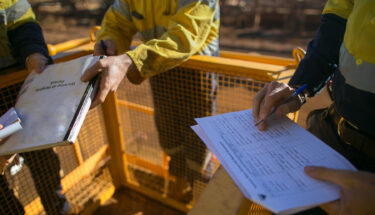This is probably the worst thing your inspections could be used for. Safety does not happen through fear. In fact, there are probably quite a few serious injuries that have occurred because people were so afraid to get caught doing something wrong, even if unintentionally, that they weren’t fully focused on the task at hand. Inspections should be a tool for reviewing procedures, enhancing employee knowledge, and preventing injury or occupational disease from occurring in the first place. Given that, what should you be looking for during an inspection?
Low-Hanging Fruit
Highly-visible, easily-recognizable, and easily-fixed problems are your low-hanging fruit. These issues can be found by anybody holding an inspection checklist. Are your workers wearing the correct PPE? Is the proper signage in place? Are barricades in place and complete? Are machines properly guarded? Is fall protection in use? Is GFCI in use? Are fire extinguishers present? It would not be difficult for you to come up with a checklist of these items and assign frequent inspections to members of your team or supervisory staff. They probably wouldn’t even need extensive safety training to perform these types of inspections. However, if this is the full extent of your inspection, then you’re doing yourself a disservice.
Procedural Fails
Your company, whether manufacturing, construction or any other, follows certain procedures. Many of these procedures have been determined for efficiency, safety, or both. Failure to follow established procedures introduces a host of unknowns into your safety program. An inspection is a good time to stop and observe certain task being performed. Are the steps being done in the right order? Is the workers utilizing proper safeguards? Are shortcuts being taken? Are safety systems being bypassed? Any of these issues, and more, demonstrate that your workforce may need to be retrained both in what the procedure is and why it is necessary for safety.
Even if none of the procedures are performed other than how they were planned, you could recognize hazards or concerns that were missed before. For instance, observing somebody working on a machine on a manufacturing floor may raise ergonomic concerns that could have been missed in the past. Watching workers performing your lockout/tagout procedures could lead you to realize a failure in your program as it is written. Make sure that you’re stopping to observe your workforce and do your best not to intrude on the process or distract the worker in any way.
Positives
Even if you’re using inspections for nothing other than identifying areas for improvement, employees may still feel beaten down if the reports always focus on nothing other than the negative. Putting positive findings in the report not only helps to boost morale, but it lets you know where you are doing things right. This could allow you to analyze why this particular procedure is being done more effectively than others, who the employees are that are making this successful, and what can be applied to other procedures on your job or in your facility.
Upgrades
The work environment is being checked. Employee performance is being checked. Procedures are being observed and analyzed. Positives are being noted. What else can be done? This is your opportunity to now see where improvements can be made to things that may already be “compliant” or “good.” Why not aim for “above and beyond” or “great”? Sure, wish lists don’t always get fulfilled, whether because of restricted budgets, failure to get the right people on board, or a variety of other reasons, but you can completely guarantee a wish list won’t get fulfilled if you never develop one in the first place. Inspections are a good opportunity to see which of the things that are being done well could also be done better.
Conclusion
While inspections could utilize a checklist that could be done by almost anybody, that should definitely be a small part of the inspection process. Full safety inspections need to be done by somebody with the proper knowledge and experience to analyze and evaluate what they are observing. The inspector needs to be knowledgeable enough to make useful recommendations for improvement. Don’t let your inspection process be a dog and pony show that you hope will fool a compliance officer. If that’s the reason behind your inspections, and not that they could potentially save a life, then you may be setting yourself up for failure.


